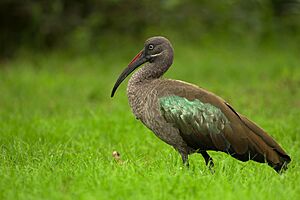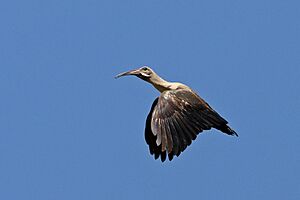Hadada ibis facts for kids
Quick facts for kids Hadada ibis |
|
|---|---|
 |
|
| In breeding plumage (Lake Naivasha, Kenya, possibly subspecies nilotica) | |
| Conservation status | |
| Scientific classification | |
| Synonyms | |
|
The hadada ibis (Bostrychia hagedash) is a cool bird from Sub-Saharan Africa. It's famous for its super loud "haa-haa-haa-de-dah" call! This sound is how it got its name. You'll often hear them flying around, especially in the mornings and evenings. Even though they are ibises, they don't need as much water as some other ibises. They like living near wetlands but also hang out close to people, often looking for food in gardens and farms. They are medium-sized birds with strong legs and a curved beak. Their wings shine with green or purple colors. Hadadas don't migrate far, but they might move around a bit when it's very dry, looking for rain. They've actually spread to more places in southern Africa because of more trees and irrigation from humans.
Contents
What's in a Name?
The hadada ibis got its scientific name, Tantalus hagedash, in 1790. It was named by John Latham. The name "hagedash" comes from the sound the bird makes. People living in the area where it was first found called it "hagedash" or "hadelde."
Today, the hadada ibis is part of the Bostrychia group of birds. There are three main types, or subspecies, of hadada ibises. The ones south of the Zambezi river are paler and have shorter beaks. Those in eastern Africa are bigger with longer beaks. Birds in western Africa are darker brown and have brighter shiny feathers.
What Does a Hadada Ibis Look Like?
The hadada is a large bird, about 76 centimeters (30 inches) long. It's mostly grey to brown. Adult hadadas weigh about 1.2 kilograms (2.65 pounds). Both male and female birds look the same.
They have a thin, white stripe across their cheeks. Some people call this a "moustache." Their wings have a shiny purple color that shimmers in the light. Hadadas have blackish legs and a big, grey-to-black beak. During breeding season, the top part of their beak turns red. Their toes also turn red when they start breeding. Their wings are strong and wide, helping them fly quickly and easily through trees.
The Hadada's Loud Call
The hadada ibis has a very loud and special "haa-haa-haa-de-dah" call. This is why it's called "onomatopoetic," meaning its name sounds like its call. You often hear this call when they are flying or if they get scared. They also use it to talk to each other, especially early in the morning in neighborhoods.
When they are resting, they make a single loud "haaaa" sound. If they are looking for food, their call is a quiet growl, like a young puppy.
Where Do Hadada Ibises Live?
Hadada ibises live all over Sub-Saharan Africa. You can find them in open grasslands, savannas, and wetlands. They also live in cities, in parks, school fields, and big gardens.
These birds live in many countries, including Sudan, Ethiopia, Kenya, South Africa, and many others. Their home range in southern Africa has grown a lot in the last 100 years. This is because more trees have been planted, and irrigation projects have made the soil moist. They need soft, wet soil to find their food.
Hadada Ibis Behavior and Life Cycle
Hadada ibises usually rest together in groups in trees. They fly out in the mornings with their loud calls and return in the evenings.
What Do Hadadas Eat?
Hadadas eat insects, millipedes, and earthworms. They use their long, curved beaks to poke into soft soil. They also eat bigger insects like the Parktown prawn, as well as spiders and small lizards. These birds love to eat snails and often clear them out of gardens. They are very helpful on golf courses because they dig up insect larvae that eat grass roots.
Like other ibises and birds that probe for food, hadadas have special sensors at the tip of their beaks. These sensors help them find hidden prey, like worms and larvae, under the ground.
Living Near Humans
Hadadas have become very common in many African cities. They are quite comfortable living close to humans. They can even tell how fast a person is approaching to decide if they need to fly away. Sometimes, hadada ibises have caused bird strikes at airports in Kenya and South Africa.
Reproduction
Hadadas are monogamous, meaning they have one mate. They are thought to stay with the same partner all year. Breeding starts after the rainy season. In the Cape province, they mostly breed from October to November.
Their nest is a platform made of twigs. They build it in a large tree, usually in a fork of a branch. Unlike most ibises, they don't nest in big groups. Both parents take turns sitting on the eggs. A clutch usually has three to four eggs. The eggs hatch after about 26 days. The parents feed their young by bringing up food from their stomachs. Sadly, many young birds fall out of the nest. The ones that survive can fly after about 33 days.
Hadada Ibises in Culture
In parts of Lesotho, the calls of hadada ibises are seen as a sign that rain is coming. The Xhosa people call them ing'ang'ane, which means black ibis. This is different from the white sacred ibis. In many African languages, the bird's name sounds like its call. For example, it's called Zililili in Chewa.
There's a story from the Bantu people in Uganda about a man and wife who turned into ibises called Mpabaana after they starved themselves during a drought so their children could eat. In Zululand, there's a saying that if you make fun of the bird, you'll get boils. If hadadas fly around a lot, it's said to mean there will be a good harvest that year. There's also a saying, utahthisele amathole eng'ang'ane, which means "he has taken the hadeda's nestlings." This is used to say someone has made a very angry person upset and needs to be careful.
Conservation Status
The hadada ibis is found in many places and is very common. Because of this, it is listed as Least Concern on the IUCN Red List. This means it is not currently in danger of disappearing.






